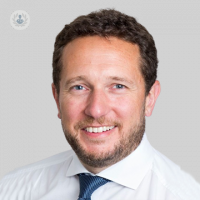Otosclerosis: what are my treatment options?
Written in association with:Otosclerosis is a rare condition where a small bone in the middle ear (the stapes) gets stuck in place as a result of bone tissue growing around it where it shouldn’t be, meaning it can no longer move freely. The stapes bone has to vibrate for a person to be able to hear well and when it can’t do that it, unfortunately, leads to hearing loss and is particularly common in young adults.
We’ve asked leading ENT specialist Professor Simon Lloyd to explain how otosclerosis occurs and how it can be treated with a procedure known as a stapedectomy.

What causes otosclerosis?
I think it would help initially just to give a bit of background in terms of the anatomy so that we can understand what's going on with otosclerosis. The ear is divided into three parts, the outer ear (the pinna) and the external auditory canal. There is the middle ear, which is the eardrum and space behind the eardrum, and finally, within the middle ear, there are three hearing bones: the malleus, the incus and the stapes.
In otosclerosis, the stapes (the innermost hearing bone) becomes fixed by a new bone formation that develops around the edge of the stapes. This means that the stapes itself can't move when sounds travel through the hearing bones and that patients get what's called a conductive hearing loss, meaning the patient has deafness due to the fact that the sound doesn't reach the inner ear adequately.
How is otosclerosis treated?
In terms of treatment for otosclerosis, there are a number of different options and it's really a personal choice as to which one a patient might want. For some people that have a mild disease affecting one ear, they might not want to have any treatment.
For other patients, a standard hearing aid would amplify the ambient sound, which will give them adequate amplification so that they can hear day to day. If somebody doesn't want to wear a hearing aid, there is a very effective operation for otosclerosis called stapedectomy.
What happens during stapedectomy?
In order to understand what's involved with the stapedectomy, it's important to understand a little bit about the anatomy of the stapes. The stapes has a flat foot plate which is in contact with the inner ear and it has an arch, which makes it look very much like a stirrup from a saddle.
In order to carry out a stapedectomy, we need to remove the arch of the stapes, which is done using a laser. Using a laser through the two crura and removing that portion, we can make a very small hole, which is only a fraction of a millimetre wide. Through that hole, we can pass a piston, which then hooks around the middle hearing bone – the incus.
Once the piston is in place, sounds hit the eardrum as it travels through the ossicular chain and it now passes through the piston, which is able to move in and out and pass the sound waves through to the cochlea unimpeded.
What’s the success rate of stapedectomy?
Stapedectomy is a very successful operation for most people. About 90% of people find that their hearing is normal, or close to normal, after the operation. The slight reservation that surgeons and patients have is that, as with any operation, there are certain risks. One of the major risks of stapedectomy is the fact that you are opening the inner ear and when you do that you potentially risk losing all the hearing with the operation. There is around a 1% risk of losing all the hearing with the operation. Despite that very small risk, most people are delighted with the outcome.
Do not hesitate to book an appointment with Professor Lloyd if you're concerned about your hearing.


